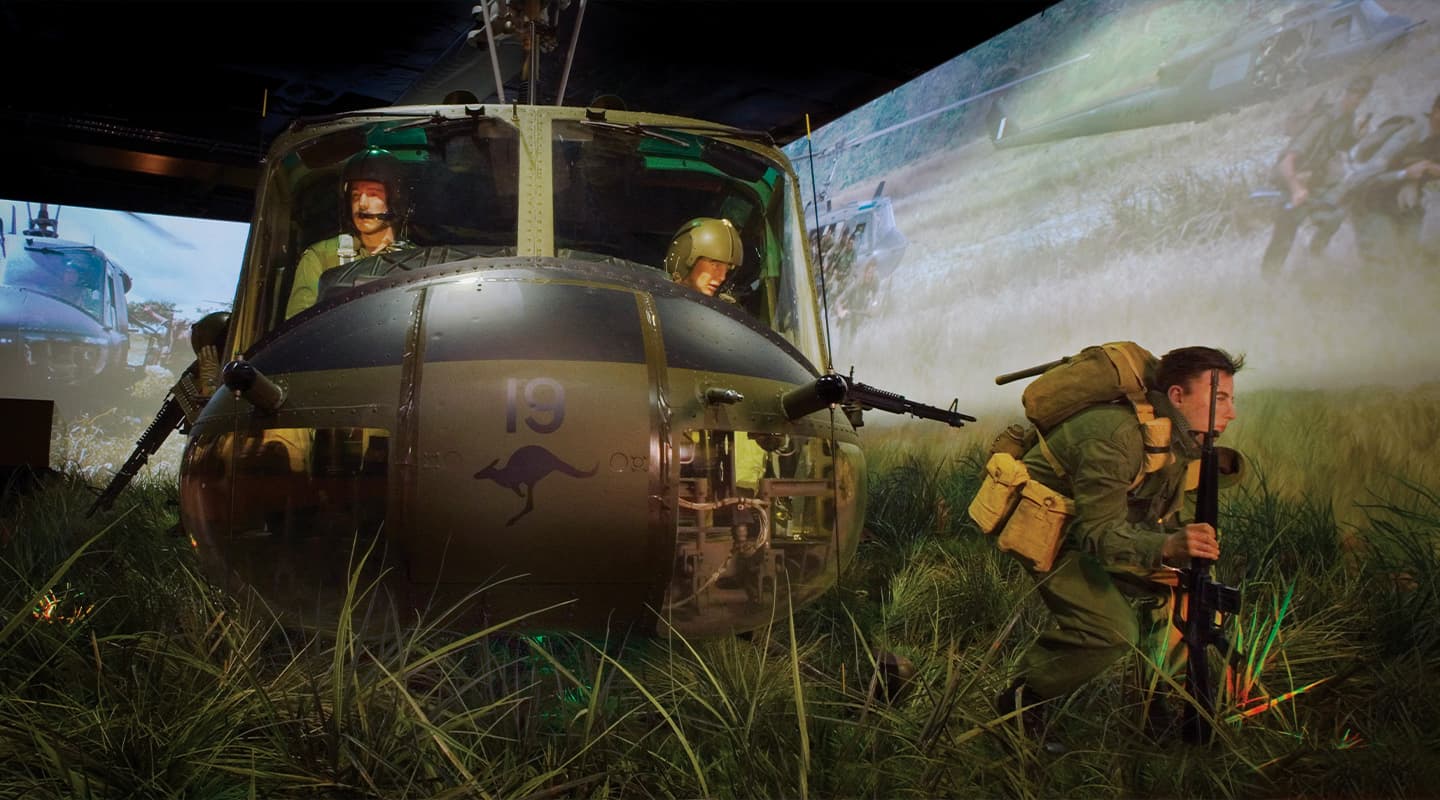
Assault On The Senses
The Australian War Memorial’s most recent exhibit brings our military history very much to life.
Text:/ Jonathan Ciddor
The Australian War Memorial has no shortage of great stories that lie at the heart of our national heritage. Its most recent project ‘Conflicts 1945 to Today’ covers the period from the Korean War (1950-53) through to our current presence in Iraq and Afghanistan. It tells the great stories from the Vietnam conflict through three elements: an Iroquois helicopter, the operations bridge from the HMAS Brisbane and the Long Tan theatre.
Bruce Brown of Mental Media, who produced the major audiovisual content for this new gallery, sees its role as encouraging visitors to suspend reality and engage them in the stories.
HELIBORNE ASSAULT EXHIBIT
The Heliborne Assault exhibit places you as a member of an infantry patrol about to be inserted into a patrol zone by Huey (a Bell UH-1B Iroquois helicopter). You receive the pre-flight briefing, then it’s up and away, across the skies in a close formation of Hueys. The sights, the noise, the wind from the rotors, the fusillade of ground fire. It’s all there, and in ever increasing intensity. Then, in an instant you are on the ground, the Hueys are gone, and the all pervading silence of the landing zone overwhelms you. You and your mates are all alone with an unseen hostile enemy.
Designing an exhibit that incorporates a full-size Iroquois helicopter (14 metres long and originally weighing 4.5 tonnes) taking off and landing every seven to 10 minutes, 364 days each year presents a number of challenges. As the Iroquois is right next to the Long Tan Theatre, audio isolation must be added to the list. The layout of the Iroquois exhibit has gone a long way to create isolation. As a backing to the exhibit, running the length of the Iroquois, is a near-rectangular screen extending four metres up from the floor. In addition to providing a spectacular series of scene-setting images that place the Iroquois in a flight with its contemporaries, the screen is tilted back slightly. Not only does this assist the projection angle, but importantly it also aids the acoustics. It’s a trick that works well to deflect the spurious reflected audio into the floor and into the ceiling. There is a similar screen across the end of the exhibit, also tilted, and also irregular in shape. The multi-projector alignment through Dataton Watchout software is a work of art.
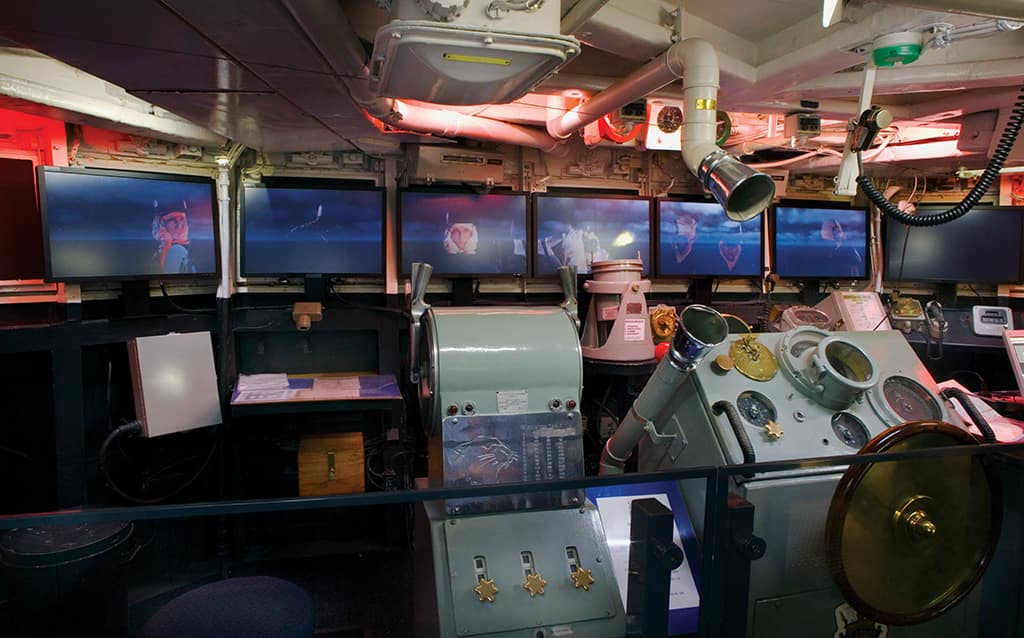
The reclaimed bridge of HMAS Brisbane.
DUST OFF
Interspersed between each Heliborne Assault is a very moving show about a ‘Dust Off’ (a helicopter medical evacuation). While researching the script for this exhibit, a low-quality radio logging tape was uncovered. It reveals the poignant account of an urgent medical evacuation of a soldier who stepped on a landmine, losing both legs. The short voice messages between the distressed patrol on the ground, air traffic control, the two Huey pilots and the base hospital, unfolds into a web of tragedy as four soldiers, a medic and a captain are lost when Huey #93B goes down.
The chilling soundtrack, edited down to 10 minutes is delivered through a 20-channel sound system peaking at 110dB, with the final mix done live in the exhibit by Resonant Design’s Nigel Frayne. Original footage is carefully interspersed with HD re-enactment footage shot specifically for this exhibit.
The lighting for the Iroquois exhibit includes Martin MX-10 moving mirror projectors, Mac 700 profile spots and a very interesting use of Martin Maniac effects. The rotating barrel mirror on the Maniac is used to simulate the effect of the ground moving below the Huey.
HMAS BRISBANE
You step through a watertight bulkhead and onto the bridge of the guided missile destroyer HMAS Brisbane. It’s not a set, it’s the actual bridge that was cut off the Brisbane before it retired to become a dive wreck.
Standing on the bridge, behind the coxswain’s chair, staring out to sea, you are transported to 1970, off the coast of Vietnam, where HMAS Brisbane was tasked to shell the coastline. LCD panels replace the Bridge’s observation windows with a seascape of the coastline, tracking with the change in bearings you hear called by the Officer of the Watch. In a stroke of genius, moving reflections of the crew can be seen in the LCD panels, bringing to life the ghost voice tracks. The footage for these ‘reflections’ required a seven camera shoot, and involved a cast in original uniforms and voice tracks with period accents, phrasings and voice procedures. The real trick was the variation in angle and apparent focal length to match their physical placement as a reflection in the appropriate LCD panel.
A second show places you in the Arabian Gulf during the 1990 Gulf War, where HMAS Brisbane was on Plane Guard providing anti-aircraft defence in the aircraft carrier screen. This show required different uniforms, seascapes, phrasing, terminology and voice procedures.
The seascapes were created as computer-generated images and then the reflections were overlaid. This was generated at 1920 x 1080 per panel and the resultant digital image, nearly 14,000 pixels wide, was generated on a render farm then split into the seven individual LCD panel images.
The lighting on the bridge requires minimal and graduated light levels in order to deliver the reflection images. The audio is presented as a soundscape delivered through 10 channels of Bose white FS3 cubes secreted around the ceiling. The final mix was, again, performed on site by Nigel Frayne.
The ‘rivet counters’ (the arbiters of authenticity) have given the entire HMAS Brisbane exhibit a resounding thumbs up.
LONG TAN THEATRE
The presentation of the story ‘A Letter Home’ is accompanied by high quality video images of the Battle of Long Tan, which took place on the 17th and 18th of August 1966. In fact, the quality seems far too good for a handheld camera in the heat of battle in a rubber plantation during a tropical thunderstorm. But as more images fly off the screen it’s easy to suspend any disbelief as you become engrossed in the emotion of Private Alan May’s letter to his mother a week after the battle, describing the raw emotion of the 12 hours of the Battle of Long Tan. The story is so simply told and the facts so devastating that you probably won’t question how it was possible for a cameraman to get shots of the embattled members of 10, 11, and 12 platoons of Delta Company, 6 Royal Australian Regiment under heavy fire. You may not notice the beautifully framed shot of the artillery observer as he directs the Australian artillery support shells ever closer to their own position and onto the advancing Viet Cong troops.
The facts are easy to recount, but difficult to comprehend. Three Australian platoons, with 17 dead and 25 wounded. Three North Vietnamese battalions with 245 dead and 1455 wounded. Although the Australians were resupplied by helicopter drops, by the end of the battle the entire Delta company had only 40 rounds of ammunition left between them, and only five members of 11 platoon were not either wounded or dead.
The high definition re-enactment footage used in the show was produced in a five-day shoot with a film crew of 30 in a hardwood plantation in Mackay, Queensland. Most of the cast were serving members of the Australian Army who were dressed and armed with items from the AWM collection, including armoured personnel carriers. The armoury for the shoot required blank and live fire from all weapons, with the footage of the 25-pound artillery guns recorded on a firing range.
In the name of authenticity, great enthusiasm was applied to reproduce the impact of the sound of the exploding artillery shells. The 5.1 sound system of Electrovoice ZX1 full range and EV CP2200 sub speakers driven by Dynacord PCL415 amplifiers could handle it with no problem at all. However, in the surrounding exhibits, precious collection items were found to be walking around the shelves of their display cases until compromise levels were set.
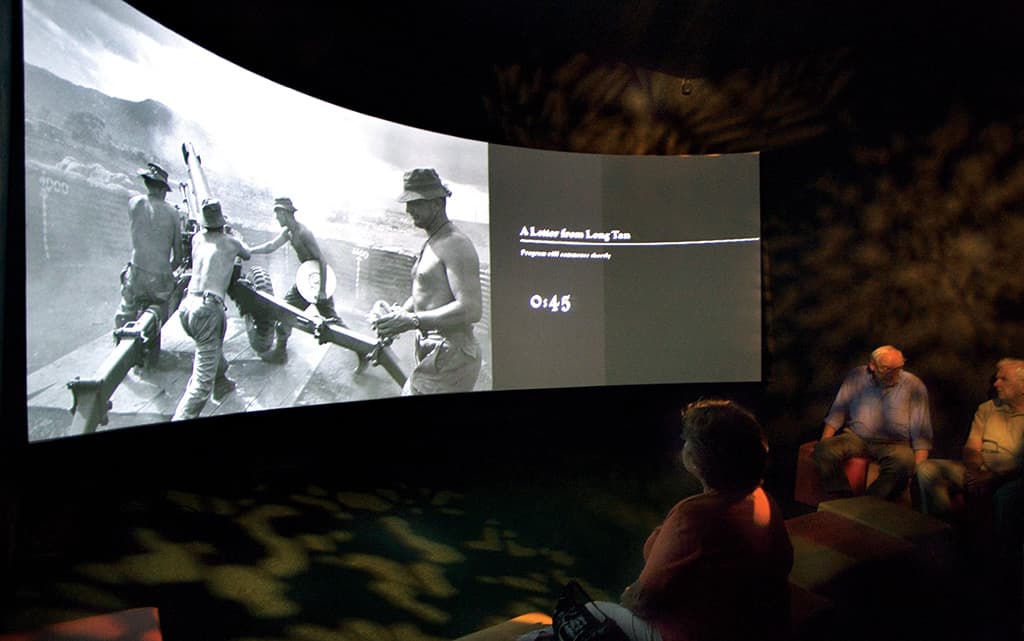
The Battle of Long Tan is under the microscope via the ‘A Letter Home’ exhibit.
GHOST IN THE MACHINES
Following the great success of the large-scale World War II AV displays Mini Sub and G for George, Alex Smythe, the AWM’s Head of AV and his staff had significant involvement in the planning process to ensure the new exhibits were easily operated and supported, utilised common componentry and were designed on a flexible, reconfigurable infrastructure base that could support their operational regime of 364 days each year.
To facilitate fast and simple maintenance processes that keep the exhibits operational, AWM has adopted a standard PC upon which it mounts its control systems. PCs can and do fail, but the key benefit of the standard machine lies in the Ghost replica of each system stored on CD. This allows a failed system to be swapped out for a cloned PC in under half an hour. All AV techs are trained in system cloning, and don’t require an in-depth knowledge of any specific system to get it up and running again.
TECHNOLOGY PLATFORMS
The Post ’45 Galleries operate on their own ethernet network, independent of the AWM’s IT network, except for some convenience links for system monitoring. Medialon is the control system brain that integrates the 35 individual AV components into one complete exhibit.
Scattered throughout the gallery are an array of small AG Nueovo and medium-sized Panasonic LCD panels, each driven by its own standard PC with a Magenta Research balun system delivering DVI video via Cat 6 cable. Some displays have localised audio through highly focused Dakota Audio Hypersonic speakers.
Pioneer V8000 DVD players are used throughout. They are a conservative choice, but with a common unit, spares are readily available for a swap out in under 15 minutes. The exhibits use Panasonic PT-D4500 and PT-D5700 DLP projectors with projection configuration, alignment and blending provided by Dataton’s Watchout software mounted on the standard PCs with HD video delivery at 1920 x 1080 resolution. Control is via Medialon.
The ‘fast and simple’ maintenance mantra is apparent in the lighting infrastructure as well. A theatrical style any-dimmer-to-any-outlet load patch system uses LSC 72-way i-Patches and LSC i-Pro dimmers located behind foldout display walls. This configuration provides a high level of service accessibility and facilitates dimmer swap-overs in just three minutes.
Active exhibit lighting, including the moving heads and effects units in the Iroquois exhibit, is under the control of a Jands Vista console using its GUI and is synchronised to Medialon via SMPTE timecode.
The major AV systems and visual content were designed by Mental Media’s Bruce Brown, with lighting design by Bluebottle. The project was delivered by Total Concept Projects under Joe Musico, with site management by Peter Guest.


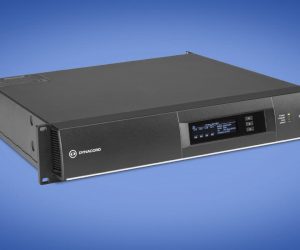

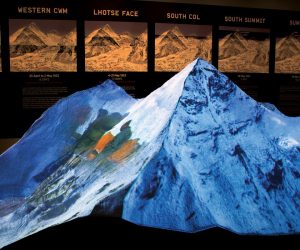
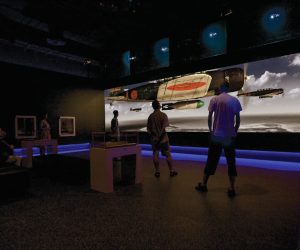

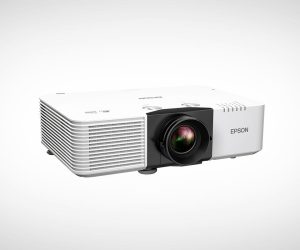
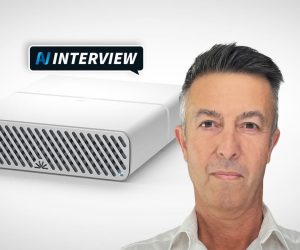


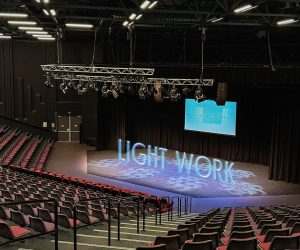
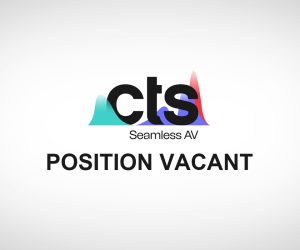


RESPONSES